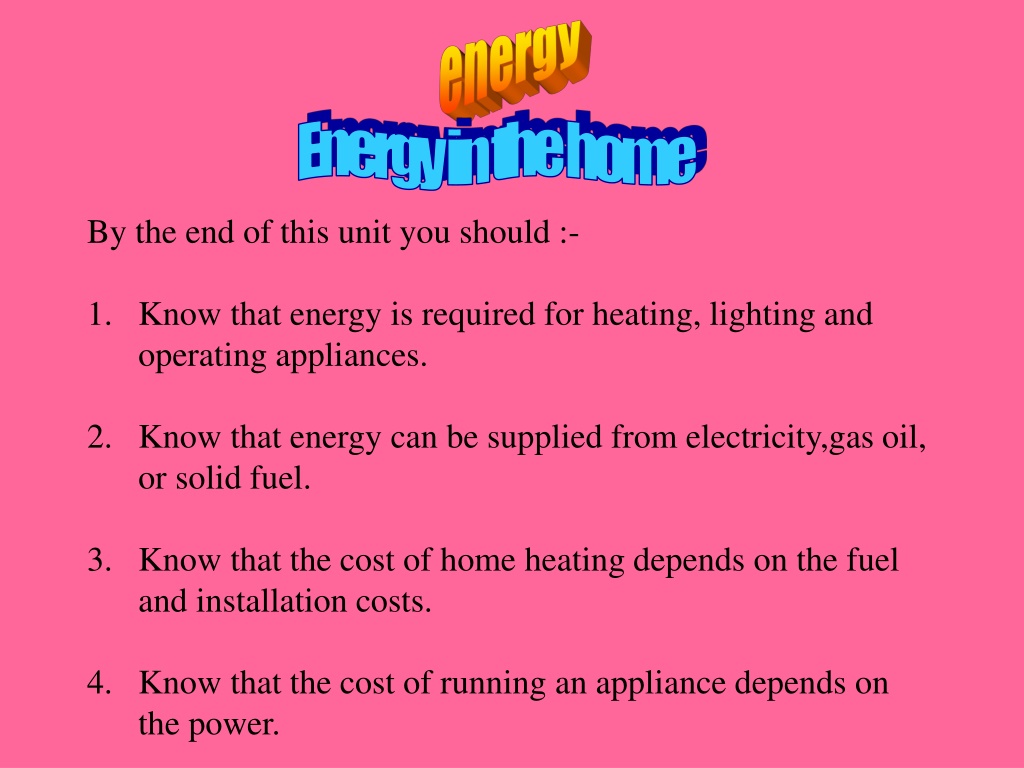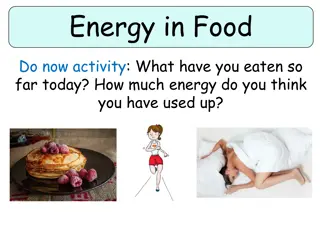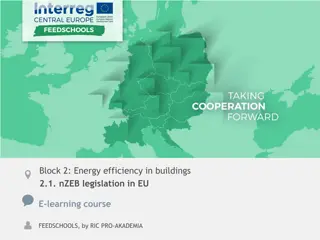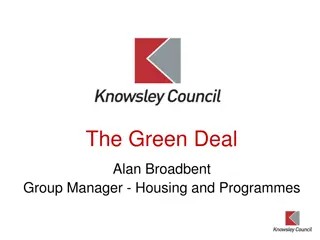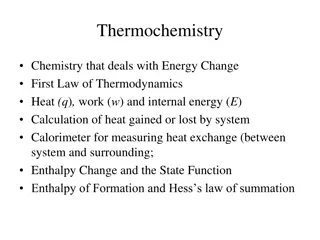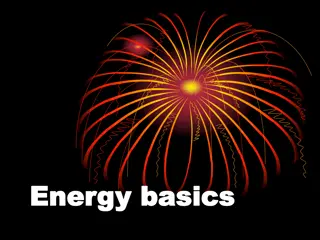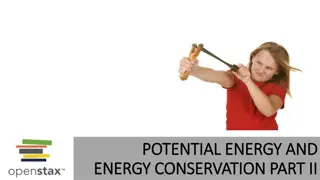Understanding Energy Usage in the Home
This unit explores energy usage in homes, covering the need for energy in heating, lighting, and appliance operation. It delves into different energy sources such as electricity, gas, and solid fuels, explaining how costs vary based on fuel types and installations. Additionally, it discusses ways to reduce energy waste and cut down on heating expenses through insulation, double glazing, and efficient appliance usage.
Download Presentation

Please find below an Image/Link to download the presentation.
The content on the website is provided AS IS for your information and personal use only. It may not be sold, licensed, or shared on other websites without obtaining consent from the author. Download presentation by click this link. If you encounter any issues during the download, it is possible that the publisher has removed the file from their server.
E N D
Presentation Transcript
Energy in the home By the end of this unit you should :- 1. Know that energy is required for heating, lighting and operating appliances. 2. Know that energy can be supplied from electricity,gas oil, or solid fuel. 3. Know that the cost of home heating depends on the fuel and installation costs. 4. Know that the cost of running an appliance depends on the power.
energy in the home 5. Know that energy costs can be calculated from the difference between two meter readings. 6. Know that energy losses cost money. 7. Know that energy can be lost by convection ,conduction and radiation. 8. Know that heat loss can be cut down by insulation, double glazing, and draught excluders. 9. Know that heat waste can be cut down by for example using showers instead of baths.
energy in the home 10. Know that many appliances use thermostats to keep a steady temperature.
heating These are the four main activities that people use energy for in a house. cooking fun
1. By looking at the picture shown, list the number of ways in which energy is used. 2. Which appliances use the most energy?
energy in the home Energy can be supplied to the home in three ways. 1. Electricity :- this is brought to us from power stations.It comes via pylons and underground cables. 2. Gas :- this comes from the north sea.It is pumped along pipelines to gas stations. 3. Solid fuel :- this is the form of coal, wood or peat.Coal is mined and peat is cut from the ground.
types of heating Most houses use either 1. Gas central heating. 2. Electric central heating. 3. Gas fires. 4. Electric fires.
uses of energy in the home Hot water 20% Room Heating 65% TV 10% cooking 10%
uses of energy in the home The next slide shows the uses of energy in the home. The uses are :- 1. Hot water 20%. T.V. ,lights etc. :-5%. Cooking :- 10%. Room heating :- 65%. 2. 3. 4. Think of other appliances and add them to the diagram.
which fuel? We see from the pie chart and previous slides that :- 1. More than two thirds of energy is used for heating and lighting. 2. This energy can come from coal , gas, or electricity. The following table compares the cost of installing and running the three different types of fuel.
which fuel cont`d? 2 Bedroom flat without cavity wall insulation Solid fuel Mains gas electricity 1200 800 installing 1400 Running Cost per year 240 210 300
which fuel cont`d? Once you have copied the previous slide, copy and answer the Following questions. 1. Which fuel is the cheapest to install? 2. Which fuel is the cheapest to use? 3. Which fuel would be least popular in flats? Why?
What do I Do with the Ashes? It s a Very dry Heat. which fuel cont`d? Here are some things that people have said about different fuels. I can switch On the heat as Soon as I come In. Its easy to use. Its dirty It smells We`re not On the Mains. Its heavy To carry. . What about Power? W e ` r
which fuel cont`d? Fill in the table below to say which fuel each comment is about. Solid fuel electricity Mains gas
using electrical energy The table below shows how a family of four used their electricity during one week. Appliance ______________________________________ hair tongs vacuum cleaner toaster fryer kettle freezer T.V. washing machine cooker oil filled radiator water heater Units 0.2 1 1.5 2 3.5 7 8 9 20 50 65
paying for electricity Use the information from the previous table to work out the cost of your electricity bill for the week.The cost of one unit of Electricity is about 7p. How much does this work out for twelve weeks? How much did they pay for the heat producing appliances?
using electrical energy Collect a sheet of graph paper and put the information on to A bar chart. _______________________ Questions. 1. Which thre appliances use the most energy? 2. What do these appliances produce?
paying for bills To calculate the following bills,you must take the previous reading away from the present reading.Then you must multiply the units by the cost of one unit which is 7p.Then you add on the fixed charge to get your total bill. Bill A Present previous units fixed charge amount 15600 15300 7p 10 ------- Bill B Present previous cubic metres kWh charges 5600 5500 100 3082
paying for bills cont`d Bill B cont`d Standing charge 8.37 Charge per kWh = 1.6p Total =
energy losses Energy can be lost from our homes in a variety of ways -: Roof 75 Windows 50 Walls 50 Door 25
energy losses As can be seen from the previous slide,energy can be lost from walls, roofs, doors and windows. To reduce these losses and in doing so ,save money,there are a number of ways this can be done.We have to make use of various ways of insulating our homes. 1. Draught proofing 2. Lagging pipes 3. Laying carpets 4. Loft insulation 5. Double glazing 6. Wall insulation
energy losses DRAUGHT PROOFING If a door or window does not shut tightly,cold air can blow in.By using plastic materials which mould into the shape of the gap,we can reduce the losses. LAGGING PIPES When hot water is going through pipes below the floor or in the loft, it can cool quickly.Lagging is a covering of fabric or foam which can cut this type of loss.
energy losses LAYING CARPETS Carpets look nice on the eye but they also provide good insulation for a room by keeping heat from escaping through the floorboards. LOFT INSULATION A thick glass wool layer up in the loft will stop heat going through the roof.
ENERGY LOSSES DOUBLE GLAZING This method of insulation sees two glass panels separated by an air free space.A side view is shown below. air free space glass glass
energy losses CAVITY WALL INSULATION The cavity or space between outer walls can be filled with material such as polystyrene foam to stop heat loss. Reducing energy waste. Have showers instead of baths. Close doors when you leave a room. Switch off heaters in rooms you are not using. Don`t boil a full kettle if you are only making one cup of tea.
simple energy savers Thermostats -: used in most homes in several situations. They turn the heating on or off in a room automatically. They can be placed on the walls in a room or on individual radiators. An oven thermostat allows you to set the oven at a certain temperature. An iron thermostat allows the iron to be set at a temperature which will not burn your clothes.
simple energy savers Your immersion heater has a thermostat to control the temperature of the water. Your kettle has a thermostat which does the same job.
simple energy savers THE THERMOSTAT HOW IT WORKS The thermostat consists of two metals stuck together back to back. brass iron Room temperature When it gets cold or hot ,one metal expands more than the other and the metal bar bends up or down.This arrangement is called a Bimetallic strip. Experiment -: place the bimetallic strip in a bunsen flame and see what happens.
simple energy savers iron iron brass cold brass hot The bimetallic strip should look as shown above.
electrical safety in the home 1. Electricity can be sent over large distances. 2. Electrical cables allow you to send electricity to different parts of a room. 3. Electricity can also be very dangerous if not treated properly. 4. An electric shock can paralyse us and cause our heart to stop beating. 5. Deaths from electric shocks is more common in young people and the elderly.
electrical safety in the home The wires in a three pin plug are coloured as follows :- 1 LIVE BROWN 2 NEUTRAL BLUE 3. EARTH GREEN/YELLOW
electrical safety in the house THE THREE PIN PLUG 1.Collect a diagram of the three pin plug which has been provided. 2.Stick it into your notebook. Information :- the earth is for safety .The fuse is for safety, and the switch is for safety.The electricity flows FROM the LIVE wire and BACK via the NEUTRAL 3.You will be shown how to wire the plug by your teacher.
electrical safety in the house INFORMATION THE THREE PIN PLUG CONT`D THE FUSE A fuse is a thin piece of wire which will melt if too much current flows through it.If more than 3 amperes flows through a 3 ampere fuse it will melt and will cause all the electricity to be switched off.This means that the plug wires cannot overheat and cause a fire.Fuses are of two types in a three pin plug. If an appliance uses more than 3 amperes(3A) then a 13 ampere fuse must be used.If it uses less than 3A then a 3A fuse is used.
ELECTRICAL ENERGY Fuses. We generally have two types of fuse , the 3Amp and the 13 Amp. The fuse is a safety device in the three pin plug. If the power of an appliance is greater than 700Watts , e.g. a kettle , we use a 13Amp fuse.If it is less than 700 Watts , e.g. a lamp , we fit a 3Amp fuse.
electrical safety in the house INFORMATION THE EARTH WIRE Normally the earth does nothing in a circuit, but if the live wire somehow touches the casing of an appliance such as a toaster, You would get an electric shock and be badly injured.To stop this happening,the earth wire causes a large current to flow.This blows the fuse and the appliance becomes dead.
NON RENEWABLE SOURCES OF ENERGY The Fossil Fuels. These are coal , oil and gas. Coal is made from dead plant material milloins of years old. Oil and Gas are made from dead sea creatures millons of years old. Once they have been used they can no longer be used and are therefore running out.
CRUDE OIL Crude oil is a mixture of hundreds of different compounds and is difficult to burn. It is taken from the worlds oil fields to refineries where it is cleaned. It is separated into different chemicals we can use. Each different chemical is separated out at a different temperature.
CRUDE OIL Crude oil products include the following , Bottled gas at 200C. Petrol at 700C for vehicles. Paraffin oil at 1700C for jets and lighting. Diesel at 2700C for trains. Lubricating oils for oil , polishes. Bitumen at 3500C for roads.
POLLUTION Burning Fuels. When fuels are burned in oxygen , heat is produced but carbon dioxide and water vapour are also produced. Sulphur dioxide and nitrogen are also produced. These gases cause global warming and acid rain.
POLLUTION Another gas is produced when fuel does not burn completely.This is called Carbon Monoxide. This gas has no smell and can cause death. Cars are now fitted with catalytic converters which convert this gas into a harmless gas.
